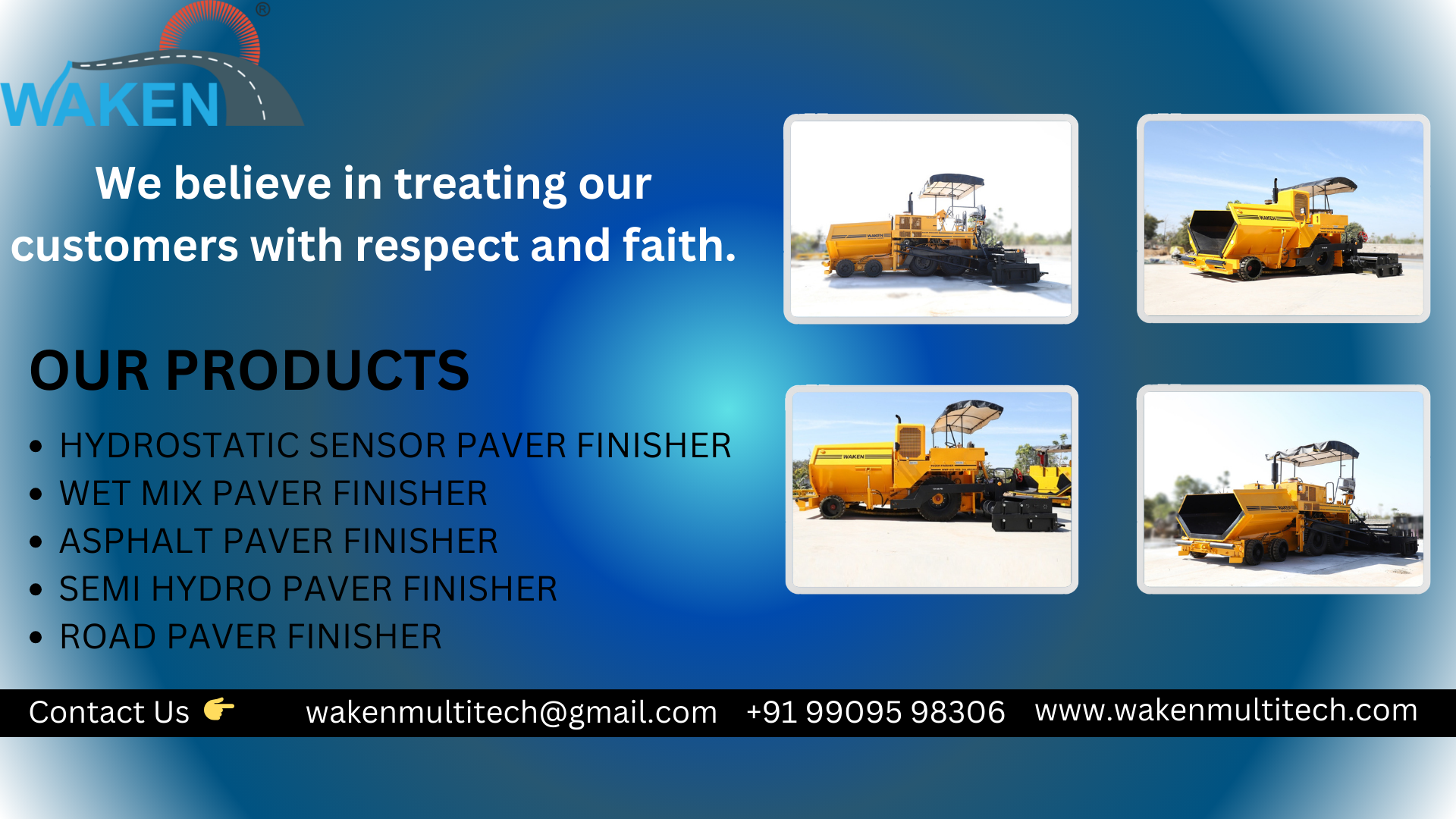Introduction to Semi Sensor Road Paver Machine
Semi Sensor Road Paver Machines deliver uniform asphalt mats while keeping ownership costs predictable for Indian contractors. A semi-sensor configuration blends manual control with automated grade and slope assistance, improving profile accuracy without full sensor complexity. Wheeled or tracked variants handle highways, urban corridors, and industrial campuses with dependable throughput. Heated screeds, robust conveyors, and efficient augers maintain material flow and texture. Operators get responsive controls, clear visibility, and straightforward maintenance access for faster turnarounds. For compatible compaction equipment, service support, and commissioning guidance, see our solutions hub designed around Indian mix designs, climate realities, and site logistics.
Working Principle and Process Flow of Semi Sensor Road Paver Machine
Hot mix is tipped into the hopper, then dual conveyors feed material toward the augers. Augers distribute a steady head of mix ahead of the heated, vibratory screed. Semi-sensor electronics read grade references and slope inputs, assisting operators to maintain thickness and crossfall while permitting manual fine-tuning. Screed heaters stabilize temperature; vibration and tamper settings control texture and initial compaction. Travel speed, paving width, and crown are adjusted to drawings. Coordinated rolling achieves target density. For setup checklists, sensor calibration notes, and plant-to-paver logistics, visit our technical resources before production runs.
Types of Semi Sensor Road Paver Machine
- Wheeled semi sensor paver for city works, quick relocation, minimal surface disturbance, and efficient performance on segmented municipal corridors.
- Tracked semi sensor paver for highways and weak bases, delivering superior traction, flotation, and stability on long pulls and challenging grades.
- Hydraulic extendable screed model enabling rapid width changes, seamless joint matching, and improved productivity across lanes, shoulders, medians, and urban approaches.
- Semi sensor paver with basic grade reference and manual slope trim, balancing affordability with measurable improvements in profile and thickness control.
- High-capacity feed arrangement supporting continuous operations, steady head of material, and uniform mats for expressways, airfields, and industrial estate arteries.
Key Features and Specifications of Semi Sensor Road Paver Machine
- Variable paving width with hydraulic extensions covering common Indian lane and shoulder dimensions accurately.
- Semi sensor grade assistance improves profile control while allowing manual fine adjustments during complex site conditions.
- Efficient conveyors and augers maintain consistent material flow, reducing segregation and enhancing mat uniformity.
- Heated vibratory screed with adjustable frequency supports texture control and initial compaction quality.
- Ergonomic controls, visibility aids, and accessible service points improve safety, uptime, and operator confidence.
Applications of Semi Sensor Road Paver Machine
- National and state highways demanding uniform thickness, density, and smoothness; semi sensor assistance helps maintain profile on long pulls while steady material flow and heated screeds preserve workability, enabling reliable compliance with IRC tolerances and concessionaire KPIs.
- Urban streets, BRT corridors, and arterial routes where quick relocations, precise widths, and minimal traffic disturbance matter; semi sensor control improves ride quality and reduces corrective work, supporting shorter closures and predictable handovers for municipal stakeholders.
- Airport runways, taxiways, and aprons needing tight elevation control and high bearing strength; semi sensor guidance assists screed adjustments, while coordinated rolling programs deliver density and texture essential for braking performance and foreign object damage reduction.
- Rural connectivity and PMGSY roads emphasizing affordability, fuel savings, and reliability; semi sensor packages balance cost with improved profile control, enabling compliant pavements that enhance accessibility, reduce travel times, and support sustained socio-economic development.
Benefits of Using Semi Sensor Road Paver Machine
- Lower lifecycle costs through reduced rework, better temperature retention, and uniform distribution; semi sensor assistance improves thickness and crossfall control, helping contractors hit performance metrics while optimizing fuel use, consumables, and labor across varied geographies and seasons.
- Improved quality consistency via assisted grade management and stabilized screed temperatures; smoother profiles and controlled mat texture reduce corrective passes, elevate ride indices, and support compliance with IRC tolerances and airport or concessionaire documentation requirements.
- Higher productivity through rapid width changes, clear operator visibility, and reliable feed systems; coordinated plant-to-paver logistics shorten waiting times, enabling faster turnarounds and steadier crew utilization for municipal, highway, and industrial estate contracts.
- Better safety and scalability with ergonomic controls, defined exclusion zones, and training-friendly interfaces; semi sensor prompts aid decision-making, while documentation trails simplify audits, warranty claims, and milestone approvals across multi-package infrastructure programs.
Top Manufacturers and Suppliers in India
India’s semi sensor road paver segment includes domestic OEMs and international brands offering localized support networks. Buyers typically compare screed technology, grade reference options, mobility type, engine compliance, and after-sales coverage. Common packages pair hydraulic extendable screeds with assisted grade controls, robust auger–conveyor systems, and intuitive operator stations. Vendors generally provide commissioning, operator training, preventive maintenance schedules, and regional spares to reduce downtime. Evaluation often weighs lifecycle cost, fuel use, warranty terms, and compatibility with local asphalt plants, rollers, and data logging practices. Shortlists favor suppliers demonstrating reliable performance across highways, urban corridors, and airfields under Indian climatic conditions and specification frameworks.
Maintenance and Safety Tips
- Inspect hopper, conveyors, augers, and screed daily; verify fasteners, guards, leaks, and hose integrity.
- Remove material build-up; lubricate bearings, chains, and pivots strictly per OEM intervals to prevent wear.
- Confirm sensor references, slope inputs, and screed temperatures; validate vibration settings before production runs.
- Brief crews on signaling, exclusion zones, emergency stops, PPE, and safe reversing with spotters.
- Stock critical spares; store electronics and hydraulics under cover to reduce moisture and heat damage.
FAQs – Semi Sensor Road Paver Machine
Contact Details
Talk to our specialists today for tailored solutions and fast assistance.
